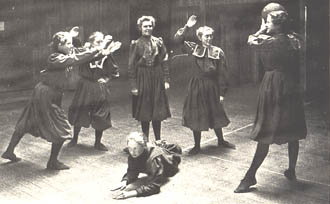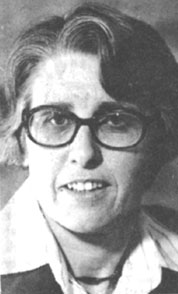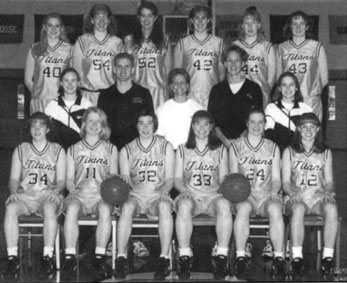![]()

Women hoopsters strike a pose, 1898-1899
According to the literature found in the Oshkosh Quiver yearbook, the women's basketball team began in 1897 at the Oshkosh Normal School. Women would gather on Friday afternoons in the lower gymnasium and play basketball with a referee officiating the match. It was considered a rewarding experienceby those who played the game. An unidentified young woman was quoted as saying, "Only pleasant results come of basketball, such as gain of ten pounds, loss of headache in twenty minutes, grace unequaled, athletic ability, and practice in mending stockings and sewing up rips" (Quiver, 1897). For this extramural sport, many women all around Oshkosh would develop teams that would play outside the university but not outside the city limits, due to a lack of funding and transportation. In 1918, it was determined that women who showed excellence in their studies and participated in athletics would receive an "O" to mark their dedication to the university. It should be noted that the women's letter was smaller in size than the men's letter because the men were said to put in more practice and game time.
During this era there was also an evolution of the rules of women's basketball. Aside from today's traditional rules, women of the early to mid-1900's were forced to limit their number of dribbles and to play half-court basketball, and they were kept from entering the lane on free throw attempts. These rules were developed because society felt that women could not withstand the physical and emotional pressure of competition. It was also a concern that jumping would be harmful to the female reproductive system if women participated in basketball. Surprisingly enough, these rules were enforced for a number of years during the post-Depression and WWII era, as well as through the 1950s.
In 1920, the Girls Athletic Association (GAA) was established for girls who had an interest in sports. In 1937 the GAA changed its name to the Women's Athletic Association (WAA). The GAA and the WAA helped to establish the foundation for influential groups like the Women's Recreation Association (WRA), which was developed in 1947 to provide female students the opportunity to participate in organized athletic activities. Women were encouraged to participate even if they possessed little knowledge or proficiency of the sport. This provided women with a golden opportunity to see what was offered and what their capabilities were. The WRA had interest groups, which allowed women to compete with other WRA women from the surrounding schools. Essentially, the WRA helped to build the idea of conferences and intercollegiate competition for women.
With the entire framework built in the previous years, it was no surprise that women's basketball would soon be considered an intercollegiate sport. With the support of the federal government and the establishment of Title IX, women's basketball was considered part of the WWIAC and was recognized as a university athletic team. But with the establishment of Title IX came great resistance from society and administration.
In 1972, Dr. Carol
Anhalt guided the newly recognized intercollegiate women's basketball
team to a five-way tie for first place. Her success continued throughout
the next 17 years as head basketball coach. During that time, Anhalt
coached the Lady Titans to numerous state tournament appearances. It was
common for Oshkosh to participate against scholarship schools, which are today referred to as Division I schools. It wasn't until 1980
that the NCAA regulated the conferences and established divisions (Anhalt,
1990).

Carol Anhalt

1996 NCAA Division III Champion Titans
Interesting facts about UWO women's basketball
- 1991-1996 - Lady
Titans compiled a record of 138-25; made eight NCAA Division III tournament
appearances; won one NCAA Division III championship; made two trips
to the NCAA Division III Final Four; and won at least a share of seven
WIAC titles.
- 1996 - UW Oshkosh
had the NCAA Division III Coach of the Year (Kathi Bennett) and Player
of the Year (Wendy Wangerin).
- 1999 - NCAA Division
III Coach of the Year (Pam Ruder).
- Albee Hall has
been the home of the UW Oshkosh women's basketball team since 1972.
There the Titan's record is 185-35 since 1975.
- Overall record
in the 1990s: 204-38.
- Only three losing
seasons in 24 years (1980, 1984 and 1986).
- 41-game winning
streak from November 18, 1995 to December 30, 1996; 26-game winning
streak from November 22, 1997 to March 13, 1998; 17-game winning streak
from November 19, 1994 to January 28, 1995.
- Coaching Record: Carol Anhalt, 186-100 (.650); Kathi Bennett, 171-40 (.787); Pam Ruder, 49-6(.891).
References
Anhalt, Carol. (March 24,1999). Personal interview of the history of Women's Basketball at UWO.
Noyes, E. and Herzing, T. (1998) Here to Serve; The First 100 Years of the University of Wisconsin Oshkosh.
Ruder, Pam. (March 2, 1999). Personal interview of Women's Basketball at UWO.
Timm, Kennan. (March 2,1999). Personal interview of Women's Basketball at UWO, primarily statistics.
The Quiver 1897, 1898, 1918, 1920, 1971,1972, and 1974.
Women's Basketball Program (1999). UWO Athletics Publication.
